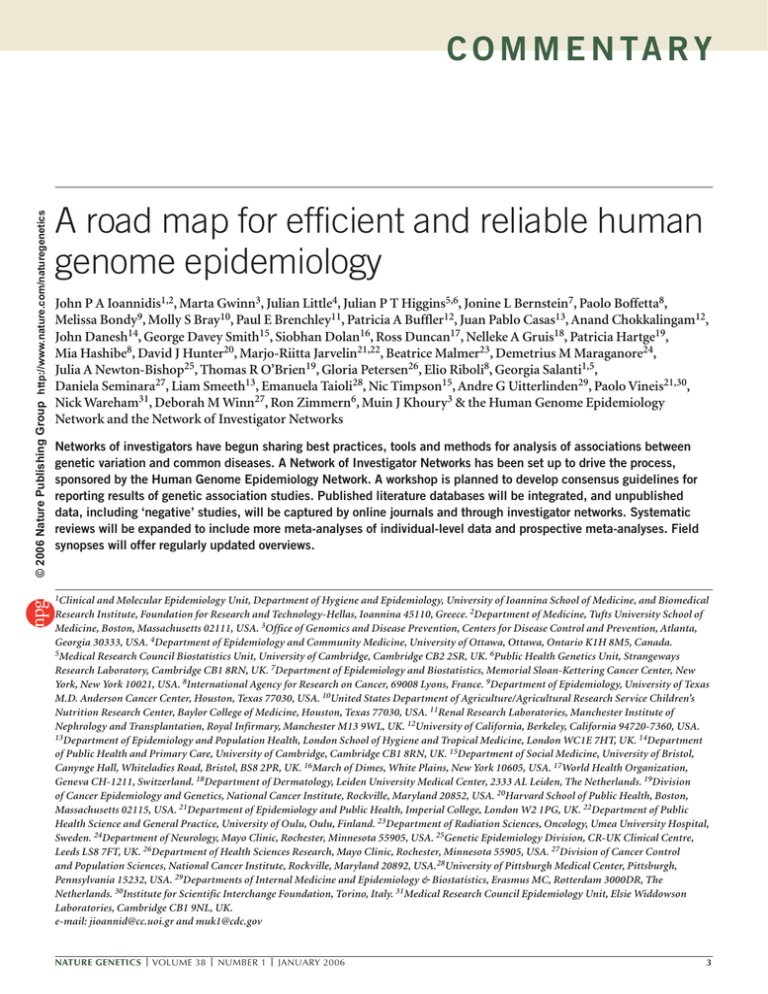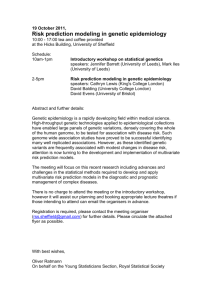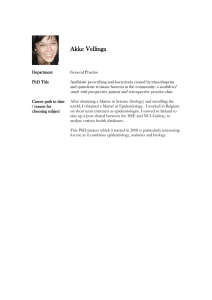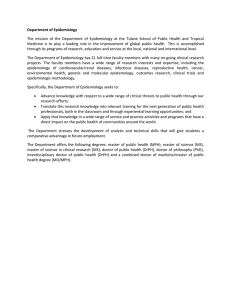A road map for efficient and reliable human genome epidemiology
advertisement

© 2006 Nature Publishing Group http://www.nature.com/naturegenetics C O M M E N TA R Y A road map for efficient and reliable human genome epidemiology John P A Ioannidis1,2, Marta Gwinn3, Julian Little4, Julian P T Higgins5,6, Jonine L Bernstein7, Paolo Boffetta8, Melissa Bondy9, Molly S Bray10, Paul E Brenchley11, Patricia A Buffler12, Juan Pablo Casas13, Anand Chokkalingam12, John Danesh14, George Davey Smith15, Siobhan Dolan16, Ross Duncan17, Nelleke A Gruis18, Patricia Hartge19, Mia Hashibe8, David J Hunter20, Marjo-Riitta Jarvelin21,22, Beatrice Malmer23, Demetrius M Maraganore24, Julia A Newton-Bishop25, Thomas R O’Brien19, Gloria Petersen26, Elio Riboli8, Georgia Salanti1,5, Daniela Seminara27, Liam Smeeth13, Emanuela Taioli28, Nic Timpson15, Andre G Uitterlinden29, Paolo Vineis21,30, Nick Wareham31, Deborah M Winn27, Ron Zimmern6, Muin J Khoury3 & the Human Genome Epidemiology Network and the Network of Investigator Networks Networks of investigators have begun sharing best practices, tools and methods for analysis of associations between genetic variation and common diseases. A Network of Investigator Networks has been set up to drive the process, sponsored by the Human Genome Epidemiology Network. A workshop is planned to develop consensus guidelines for reporting results of genetic association studies. Published literature databases will be integrated, and unpublished data, including ‘negative’ studies, will be captured by online journals and through investigator networks. Systematic reviews will be expanded to include more meta-analyses of individual-level data and prospective meta-analyses. Field synopses will offer regularly updated overviews. 1Clinical and Molecular Epidemiology Unit, Department of Hygiene and Epidemiology, University of Ioannina School of Medicine, and Biomedical Research Institute, Foundation for Research and Technology-Hellas, Ioannina 45110, Greece. 2Department of Medicine, Tufts University School of Medicine, Boston, Massachusetts 02111, USA. 3Office of Genomics and Disease Prevention, Centers for Disease Control and Prevention, Atlanta, Georgia 30333, USA. 4Department of Epidemiology and Community Medicine, University of Ottawa, Ottawa, Ontario K1H 8M5, Canada. 5Medical Research Council Biostatistics Unit, University of Cambridge, Cambridge CB2 2SR, UK. 6Public Health Genetics Unit, Strangeways Research Laboratory, Cambridge CB1 8RN, UK. 7Department of Epidemiology and Biostatistics, Memorial Sloan-Kettering Cancer Center, New York, New York 10021, USA. 8International Agency for Research on Cancer, 69008 Lyons, France. 9Department of Epidemiology, University of Texas M.D. Anderson Cancer Center, Houston, Texas 77030, USA. 10United States Department of Agriculture/Agricultural Research Service Children’s Nutrition Research Center, Baylor College of Medicine, Houston, Texas 77030, USA. 11Renal Research Laboratories, Manchester Institute of Nephrology and Transplantation, Royal Infirmary, Manchester M13 9WL, UK. 12University of California, Berkeley, California 94720-7360, USA. 13Department of Epidemiology and Population Health, London School of Hygiene and Tropical Medicine, London WC1E 7HT, UK. 14Department of Public Health and Primary Care, University of Cambridge, Cambridge CB1 8RN, UK. 15Department of Social Medicine, University of Bristol, Canynge Hall, Whiteladies Road, Bristol, BS8 2PR, UK. 16March of Dimes, White Plains, New York 10605, USA. 17World Health Organization, Geneva CH-1211, Switzerland. 18Department of Dermatology, Leiden University Medical Center, 2333 AL Leiden, The Netherlands. 19Division of Cancer Epidemiology and Genetics, National Cancer Institute, Rockville, Maryland 20852, USA. 20Harvard School of Public Health, Boston, Massachusetts 02115, USA. 21Department of Epidemiology and Public Health, Imperial College, London W2 1PG, UK. 22Department of Public Health Science and General Practice, University of Oulu, Oulu, Finland. 23Department of Radiation Sciences, Oncology, Umea University Hospital, Sweden. 24Department of Neurology, Mayo Clinic, Rochester, Minnesota 55905, USA. 25Genetic Epidemiology Division, CR-UK Clinical Centre, Leeds LS8 7FT, UK. 26Department of Health Sciences Research, Mayo Clinic, Rochester, Minnesota 55905, USA. 27Division of Cancer Control and Population Sciences, National Cancer Institute, Rockville, Maryland 20892, USA.28University of Pittsburgh Medical Center, Pittsburgh, Pennsylvania 15232, USA. 29Departments of Internal Medicine and Epidemiology & Biostatistics, Erasmus MC, Rotterdam 3000DR, The Netherlands. 30Institute for Scientific Interchange Foundation, Torino, Italy. 31Medical Research Council Epidemiology Unit, Elsie Widdowson Laboratories, Cambridge CB1 9NL, UK. e-mail: jioannid@cc.uoi.gr and muk1@cdc.gov NATURE GENETICS | VOLUME 38 | NUMBER 1 | JANUARY 2006 3 C O M M E N TA R Y Single teams Single studies © 2006 Nature Publishing Group http://www.nature.com/naturegenetics Feedback Field-wide synopses Reporting HuGENet Network of Networks Grading Published and unpublished data Synthesis Systematic reviews Meta-analyses Figure 1 Framework for risk evaluation in genetic association studies. G enetic epidemiologists and geneticists face the challenge of creating an efficient and reliable compilation of the evidence for genetic risk contributions to common human diseases (a ‘risk engine’1). Although data relating DNA sequence variation to disease states and/or intermediate traits are accumulating exponentially, the current situation is plagued with problems2,3. These include the prevalence of small, underpowered studies, often with flawed designs, suboptimal conduct and biased analyses; selective reporting of ‘positive’ results; lack of standardization among studies; poor reporting of results even from well-conducted studies; and difficulties in assessing interactions with environmental risk factors4. Consequently, the research evidence is fragmented, and the interface between epidemiological and other biological evidence is poorly developed. It remains unclear how to keep track of the rapidly evolving evidence across fields that can be defined by disease, genes or exposures, and how to rate the credibility of this evidence. The Human Genome Epidemiology Network (HuGENet), a global initiative committed to the development and integration of the knowledge base on human genetic variants and health (http://www.cdc.gov/genomics/hugenet), proposes a plan for developing this knowledge base and making it efficient and reliable. Several interrelated and synergistic actions are currently underway within this framework (Table 1 and Fig. 1). Whatever advances are to be achieved in human genome epidemiology, they should be developed, adopted and promoted by the investigators themselves. The first step was the creation of a Network of Investigator Networks3 in 2005 (Table 1, Step 1). Investigator networks comprise teams of researchers working on a common theme (for example, on a 4 specific disease, a set of genes or on modulating exposures). These networks will promote large-scale evidence with rigorous methods and will be instrumental in driving Steps 2–5. At an October 2005 meeting in Cambridge, UK, experiences were shared by representatives of 27 such networks; the networks comprise several hundred research teams and several thousand investigators working in human genetics (see http://www.hugenet.org.uk). As it may be impractical to create a single consortium for all investigators in some themes, we encourage both plurality and large-scale evidence through communication of consortia with complementary research agendas. Collaborating investigators can reach common agreement on overall study design, definitions of phenotypes, exposures and endpoints, as well as analyses of gene-disease associations and gene-gene and gene-environment interactions (Table 1, Step 2). Agreement on gene variants to be genotyped is critical at the design stage, if the subsequent information is to be combined. In the absence of common, completely standardized methods or genotyping platforms, only prospectively planned consortia can achieve this. Moreover, some issues are specific to a field or research question, but many issues that arise in conducting and reporting genetic association studies are common across diverse fields. To help provide guidance for reporting study results, HuGENet is planning the development in 2006 of an extension of the STROBE (for ‘strengthening the reporting of observational studies in epidemiology’) statement for genetic epidemiology (http://www.strobe-statement.org). A HuGE-STROBE guideline statement will offer an objective checklist that can be widely adopted by journals, analogous to similar initiatives in clinical trials (CONSORT)5 or microarray studies (MIAME)6. Such guidelines will also be useful for future studies of large population cohorts and biobanks; many such efforts are underway or being planned in different parts of the world, harmonized for international collaboration under the Public Population Project in Genomics initiative (http://www.p3gconsortium.org). We do not expect that the HuGE-STROBE guideline will replace peer review, but it will offer guidance for investigators, peer reviewers and editors on improving the quality of the studies and will aid their assessment before publication. Meeting the reporting requirements may result in longer manuscripts, but all statistical steps, assumptions and processing can be documented in supplementary files. HuGENet has already created a database (HuGEPubLit) that aims to capture published genetic association articles as they are indexed in Medline. As of November 2005, the database has over 18,500 entries. This effort will be extended to other databases such as EMBASE and will seek synergy with ongoing, similar initiatives such as the US National Institutes of Health (NIH)-sponsored Genetic Associations Database (GAD, http://geneticassociationdb. nih.gov). Similar efforts are ongoing in pharmacogenetics and pharmacogenomics (http:// www.pharmgkb.org)7. These databases need search tools, and they should encompass both published and deposited data (Table 1, Step 3). Retrieving unpublished data is currently very problematic, and unpublished reports often present ‘negative’ results from well-conducted studies. A research environment that promotes and rewards only results that reach formal statistical significance8,9 is likely to foster data dredging and will create a distorted literature with very low credibility10–12. Comparisons of primary outcomes defined in trial protocols with those defined in published articles have provided empirical evidence of selective reporting even for randomized controlled trials13. Selective reporting of extensive exploratory analyses would be almost impossible to detect in studies of gene-disease associations and related interactions, even by the most sophisticated methodologists and expert peer reviewers. The protocols of these studies are rarely available for scrutiny, and there is currently no formal way for registering analyses in advance of publication. HuGENet is working with journals and collaborating in efforts to create online journals to encourage publication of ‘negative’ results after appropriate methodological appraisal and with due credit to the investigators. The citable, peer-reviewed Molecule Pages of the Alliance for Cell Signalling VOLUME 38 | NUMBER 1 | JANUARY 2006 | NATURE GENETICS © 2006 Nature Publishing Group http://www.nature.com/naturegenetics C O M M E N TA R Y (http://www.signaling-gateway.org/molecule), which compiles information about proteins involved in cell signaling, offers an analogous example where online publications with DOI numbers can have high visibility. These online deposited association data should be searchable in the integrated databases. Peer review will be promoted and facilitated, not replaced, by guidance as in STROBE. In addition, investigators participating in the Network of Networks have also agreed that network-specific, distributed databases can be developed to capture the data produced by network members. ‘Negative’ results from members of a consortium would get authorship credit when their results are incorporated in large-scale data syntheses, including prospective meta-analyses in which single teams work on studies with the explicit purpose of meta-analysis. Finally, journal editors can have an important role in preventing bias by basing editorial decisions primarily on study quality, relevance and methodological rigor, rather than formal statistical significance alone14. The epidemiologic evidence for gene-disease association requires replication, validation and synthesis (Table 1, Step 4). Forty systematic reviews have been published according to specific HuGENet guidelines, and the HuGE Pub Lit database includes more than 250 metaanalyses and other systematic reviews that have been published elsewhere (http://www.cdc. gov/genomics/hugenet). However, the effort needs to be intensified as data increase exponentially. Many journals have already shown interest in publishing these research products. Meta-analyses are widely accepted as the highest level of evidence in medicine and they are currently the most cited study design in the health sciences15. HuGENet recently created an updated, detailed guidance document, which will be available online in 2006, for the conduct of systematic reviews and meta-analyses, and we are actively developing new data synthesis methodologies. Increasingly, we would like to promote meta-analyses conducted by consortia of investigators working in the same field, including meta-analyses of individual-level data and prospective designs16. A key aspect of the road map is the development of widely accepted rules for assessing the evidence for causal inference in genetic association studies. Several investigators and journals have already suggested criteria1,17–23, including the transparency of the data processing, magnitude and significance of the proposed genetic effect, extent of replication, protection from bias and concomitant supporting biological evidence. Adequate sample size is essential but not necessarily sufficient. We should distinguish between tools such as STROBE, which try to enhance the transparency and quality of reporting of single studies, from the tools that would grade the cumulative evidence in all the studies (both published and unpublished data) on a research question. To this end, HuGENet is planning a meeting in 2006 to develop a consensus on grading the evidence. Finally, there is a need for up-to-date summaries of the genetic association knowledge base in order to identify gaps, avoid wasteful duplication and promote the translation of this knowledge to public health and medical applications (Table 1, Step 5). Systematic reviews and meta-analyses are tailored towards addressing specific gene-disease associations—usually one or a few at a time. However, for many diseases Table 1 Steps and near-term action items in the human genome epidemiology road map Steps Action items 1. Develop a Network of Investigator Networks Create capacity to accomplish steps 2–5 below 2. Improve study conduct, reporting and harmonization across studies Share among networks best practices, tools and analytic methods; develop STROBE criteria for genetic association studies (consensus workshop planned for 2006); single studies performed with eventual meta-analysis in mind 3. Capture published and unpublished Integrate published literature databases; capture data regardless of ‘positive’ or unpublished data (online journals, networks); enhance ‘negative’ results transparency of methods and critical appraisal; develop comprehensive search engines 4. Improve data synthesis methods and integrate the evidence on specific associations 5. Capture and appraise the evidence Develop widely accepted criteria for appraising on the evolving ‘big picture’ across evidence; initiate pilot phase for specific fields; whole fields hold consensus meeting for guidelines on grading the evidence in 2006; continue empirical research; publish regularly updated synopses of the knowledge base; identify knowledge gaps Finalize HuGE handbook for conducting systematic reviews; promote methods for meta-analyses of individual-level data; expand database of HuGE reviews and other systematic reviews and meta-analyses; facilitate meta-analyses from consortia NATURE GENETICS | VOLUME 38 | NUMBER 1 | JANUARY 2006 or fields, the number of tested associations is currently large and growing24. Faced with many ‘negative’ and few credible positive results, one should consider the development of ‘field synopses’, succinct summaries of the evidence from genetic epidemiology in a particular field. Annual synopses by consortia of authors of unpublished studies might be submitted to journals annually for peer review. Synopses will become even more important as whole-genome association studies become increasingly common. Pilot projects have already begun for osteoporosis, Parkinson disease, acute leukemia and preterm birth. Our goal is to establish a dynamic, online encyclopedia of the association between genetic variation and human health that is updated regularly and linked to studies that meet quality criteria. Synopses will also identify knowledge gaps, helping to guide future research efforts. The success of the proposed initiatives hinges on investigators around the globe joining forces in these initiatives and on the collaboration of journal editors. We believe that such inclusiveness coupled with methodological rigor will be instrumental in developing an efficient and reliable human genome epidemiology risk engine. 1. Anonymous. Nat. Genet. 37, 1153 (2005). 2. Little, J. et al. Am. J. Epidemiol. 157, 667–673 (2003). 3. Ioannidis, J.P. et al. Am. J. Epidemiol. 162, 302–304 (2005). 4. von Elm, E. & Egger, M. Br. Med. J. 329, 868–869 (2004). 5. Altman, D.G. et al. Ann. Intern. Med. 134, 663–694 (2001). 6. Brazma, A. et al. Nat. Genet. 29, 365–371 (2001). 7. Thorn, C.F., Klein, T.E. & Altman, R.B. Methods Mol. Biol. 311, 179–191 (2005). 8. Pan, Z., Trikalinos, T.A., Kavvoura, F.K., Lau, J. & Ioannidis, J.P. PLoS Med. 2, e334 (2005). 9. Easterbrook, P.J., Berlin, J.A., Gopalan, R. & Matthews, D.R. Lancet 337, 867–872 (1991). 10. Greenland, S. J. R. Stat. Soc. [Ser. A] 168, 267–306 (2005). 11. Wacholder, S., Chanock, S., Garcia-Closas, M., El Ghormli, L. & Rothman, N. J. Natl. Cancer Inst. 96, 434–442 (2004). 12. Ioannidis, J.P. PLoS Med. 2, e124 (2005). 13. Chan, A.W., Hrobjartsson, A., Haahr, M.T., Gotzsche, P.C. & Altman, D.G. J. Am. Med. Assoc. 291, 2457–2465 (2004). 14. Patterson, M. & Cardon, L. PLoS Biol. 3, e327 (2005). 15. Patsopoulos, N.A., Analatos, A.A. & Ioannidis, J.P. J. Am. Med. Assoc. 293, 2362–2366 (2005). 16. Ioannidis, J.P., Rosenberg, P.S., Goedert, J.J. & O’Brien, T.R. Am. J. Epidemiol. 156, 204–210 (2002). 17. Rebbeck, T.R. et al. Cancer Epidemiol. Biomarkers Prev. 13, 1985–1986 (2004). 18. Ioannidis, J.P. Int. J. Epidemiol. (in the press). 19. Huizinga, T.W., Pisetsky, D.S. & Kimberly, R.P. Arthritis Rheum. 50, 2066–2071 (2004). 20. Freimer, N.B. & Sabatti, C. Hum. Mol. Genet. 14, 2481– 2483 (2005). 21. Wacholder, S. Cancer Epidemiol. Biomarkers Prev. 14, 1361 (2005). 22. Weiss, S.T. Am. J. Respir. Crit. Care Med. 164, 2014– 2015 (2001). 23. Cooper, D.N., Nussbaum, R.L. & Krawczak, M. Hum. Genet. 110, 207–208 (2002). 24. Marchini, J., Donnelly, P. & Cardon, L.R. Nat. Genet. 37, 413–417 (2005). 5




